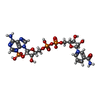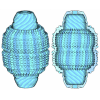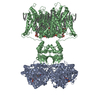[English] 日本語
 Yorodumi
Yorodumi- EMDB-9024: The voltage-activated Kv1.2-2.1 paddle chimera channel in lipid n... -
+ Open data
Open data
- Basic information
Basic information
| Entry | Database: EMDB / ID: EMD-9024 | |||||||||
|---|---|---|---|---|---|---|---|---|---|---|
| Title | The voltage-activated Kv1.2-2.1 paddle chimera channel in lipid nanodiscs | |||||||||
 Map data Map data | Kv1.2-2.1 paddle chimera in lipid nanodiscs, entire protein | |||||||||
 Sample Sample |
| |||||||||
 Keywords Keywords | MEMBRANE PROTEIN / transport protein / potassium channel / lipid nanodisc | |||||||||
| Function / homology |  Function and homology information Function and homology informationoptic nerve structural organization / pinceau fiber / methylglyoxal reductase (NADPH) (acetol producing) activity / Voltage gated Potassium channels / potassium channel complex / voltage-gated monoatomic ion channel activity involved in regulation of postsynaptic membrane potential / : / paranodal junction / regulation of circadian sleep/wake cycle, non-REM sleep / potassium ion export across plasma membrane ...optic nerve structural organization / pinceau fiber / methylglyoxal reductase (NADPH) (acetol producing) activity / Voltage gated Potassium channels / potassium channel complex / voltage-gated monoatomic ion channel activity involved in regulation of postsynaptic membrane potential / : / paranodal junction / regulation of circadian sleep/wake cycle, non-REM sleep / potassium ion export across plasma membrane / regulation of protein localization to cell surface / corpus callosum development / delayed rectifier potassium channel activity / voltage-gated monoatomic ion channel activity involved in regulation of presynaptic membrane potential / : / axon initial segment / juxtaparanode region of axon / Oxidoreductases; Acting on the CH-OH group of donors; With NAD+ or NADP+ as acceptor / outward rectifier potassium channel activity / myoblast differentiation / regulation of potassium ion transmembrane transport / Neutrophil degranulation / optic nerve development / neuronal cell body membrane / neuromuscular process / regulation of dopamine secretion / lamellipodium membrane / action potential / kinesin binding / voltage-gated potassium channel activity / potassium channel regulator activity / hematopoietic progenitor cell differentiation / neuronal action potential / axon terminus / voltage-gated potassium channel complex / sensory perception of pain / potassium ion transmembrane transport / calyx of Held / protein localization to plasma membrane / postsynaptic density membrane / potassium ion transport / protein homooligomerization / cerebral cortex development / cytoplasmic side of plasma membrane / lamellipodium / presynaptic membrane / perikaryon / transmembrane transporter binding / postsynaptic membrane / cytoskeleton / neuron projection / postsynaptic density / endosome / protein heterodimerization activity / axon / neuronal cell body / dendrite / endoplasmic reticulum membrane / protein-containing complex binding / glutamatergic synapse / membrane / plasma membrane / cytosol Similarity search - Function | |||||||||
| Biological species |  | |||||||||
| Method | single particle reconstruction / cryo EM / Resolution: 3.3 Å | |||||||||
 Authors Authors | Matthies D / Bae C | |||||||||
 Citation Citation |  Journal: Elife / Year: 2018 Journal: Elife / Year: 2018Title: Single-particle cryo-EM structure of a voltage-activated potassium channel in lipid nanodiscs. Authors: Doreen Matthies / Chanhyung Bae / Gilman Es Toombes / Tara Fox / Alberto Bartesaghi / Sriram Subramaniam / Kenton Jon Swartz /  Abstract: Voltage-activated potassium (Kv) channels open to conduct K ions in response to membrane depolarization, and subsequently enter non-conducting states through distinct mechanisms of inactivation. X- ...Voltage-activated potassium (Kv) channels open to conduct K ions in response to membrane depolarization, and subsequently enter non-conducting states through distinct mechanisms of inactivation. X-ray structures of detergent-solubilized Kv channels appear to have captured an open state even though a non-conducting C-type inactivated state would predominate in membranes in the absence of a transmembrane voltage. However, structures for a voltage-activated ion channel in a lipid bilayer environment have not yet been reported. Here we report the structure of the Kv1.2-2.1 paddle chimera channel reconstituted into lipid nanodiscs using single-particle cryo-electron microscopy. At a resolution of ~3 Å for the cytosolic domain and ~4 Å for the transmembrane domain, the structure determined in nanodiscs is similar to the previously determined X-ray structure. Our findings show that large differences in structure between detergent and lipid bilayer environments are unlikely, and enable us to propose possible structural mechanisms for C-type inactivation. | |||||||||
| History |
|
- Structure visualization
Structure visualization
| Movie |
 Movie viewer Movie viewer |
|---|---|
| Structure viewer | EM map:  SurfView SurfView Molmil Molmil Jmol/JSmol Jmol/JSmol |
| Supplemental images |
- Downloads & links
Downloads & links
-EMDB archive
| Map data |  emd_9024.map.gz emd_9024.map.gz | 132.6 MB |  EMDB map data format EMDB map data format | |
|---|---|---|---|---|
| Header (meta data) |  emd-9024-v30.xml emd-9024-v30.xml emd-9024.xml emd-9024.xml | 19.4 KB 19.4 KB | Display Display |  EMDB header EMDB header |
| Images |  emd_9024.png emd_9024.png | 154.4 KB | ||
| Masks |  emd_9024_msk_1.map emd_9024_msk_1.map | 216 MB |  Mask map Mask map | |
| Filedesc metadata |  emd-9024.cif.gz emd-9024.cif.gz | 6.9 KB | ||
| Others |  emd_9024_additional.map.gz emd_9024_additional.map.gz | 200.8 MB | ||
| Archive directory |  http://ftp.pdbj.org/pub/emdb/structures/EMD-9024 http://ftp.pdbj.org/pub/emdb/structures/EMD-9024 ftp://ftp.pdbj.org/pub/emdb/structures/EMD-9024 ftp://ftp.pdbj.org/pub/emdb/structures/EMD-9024 | HTTPS FTP |
-Related structure data
| Related structure data |  6ebkMC  9025C  9026C  6eblC  6ebmC C: citing same article ( M: atomic model generated by this map |
|---|---|
| Similar structure data |
- Links
Links
| EMDB pages |  EMDB (EBI/PDBe) / EMDB (EBI/PDBe) /  EMDataResource EMDataResource |
|---|---|
| Related items in Molecule of the Month |
- Map
Map
| File |  Download / File: emd_9024.map.gz / Format: CCP4 / Size: 216 MB / Type: IMAGE STORED AS FLOATING POINT NUMBER (4 BYTES) Download / File: emd_9024.map.gz / Format: CCP4 / Size: 216 MB / Type: IMAGE STORED AS FLOATING POINT NUMBER (4 BYTES) | ||||||||||||||||||||||||||||||||||||||||||||||||||||||||||||||||||||
|---|---|---|---|---|---|---|---|---|---|---|---|---|---|---|---|---|---|---|---|---|---|---|---|---|---|---|---|---|---|---|---|---|---|---|---|---|---|---|---|---|---|---|---|---|---|---|---|---|---|---|---|---|---|---|---|---|---|---|---|---|---|---|---|---|---|---|---|---|---|
| Annotation | Kv1.2-2.1 paddle chimera in lipid nanodiscs, entire protein | ||||||||||||||||||||||||||||||||||||||||||||||||||||||||||||||||||||
| Projections & slices | Image control
Images are generated by Spider. | ||||||||||||||||||||||||||||||||||||||||||||||||||||||||||||||||||||
| Voxel size | X=Y=Z: 0.835 Å | ||||||||||||||||||||||||||||||||||||||||||||||||||||||||||||||||||||
| Density |
| ||||||||||||||||||||||||||||||||||||||||||||||||||||||||||||||||||||
| Symmetry | Space group: 1 | ||||||||||||||||||||||||||||||||||||||||||||||||||||||||||||||||||||
| Details | EMDB XML:
CCP4 map header:
| ||||||||||||||||||||||||||||||||||||||||||||||||||||||||||||||||||||
-Supplemental data
-Mask #1
| File |  emd_9024_msk_1.map emd_9024_msk_1.map | ||||||||||||
|---|---|---|---|---|---|---|---|---|---|---|---|---|---|
| Projections & Slices |
| ||||||||||||
| Density Histograms |
-Additional map: Kv1.2-2.1 paddle chimera in lipid nanodiscs, additional map
| File | emd_9024_additional.map | ||||||||||||
|---|---|---|---|---|---|---|---|---|---|---|---|---|---|
| Annotation | Kv1.2-2.1 paddle chimera in lipid nanodiscs, additional map | ||||||||||||
| Projections & Slices |
| ||||||||||||
| Density Histograms |
- Sample components
Sample components
-Entire : Voltage-activated potassium channel Kv1.2-2.1 paddle chimera in l...
| Entire | Name: Voltage-activated potassium channel Kv1.2-2.1 paddle chimera in lipid nanodiscs |
|---|---|
| Components |
|
-Supramolecule #1: Voltage-activated potassium channel Kv1.2-2.1 paddle chimera in l...
| Supramolecule | Name: Voltage-activated potassium channel Kv1.2-2.1 paddle chimera in lipid nanodiscs type: complex / ID: 1 / Parent: 0 / Macromolecule list: #1-#2 |
|---|---|
| Source (natural) | Organism:  |
| Molecular weight | Theoretical: 385 KDa |
-Macromolecule #1: Voltage-gated potassium channel subunit beta-2
| Macromolecule | Name: Voltage-gated potassium channel subunit beta-2 / type: protein_or_peptide / ID: 1 / Number of copies: 4 / Enantiomer: LEVO |
|---|---|
| Source (natural) | Organism:  |
| Molecular weight | Theoretical: 37.339059 KDa |
| Recombinant expression | Organism:  Komagataella pastoris (fungus) Komagataella pastoris (fungus) |
| Sequence | String: MVQFYRNLGK SGLRVSCLGL GTWVTFGGQI TDEMAEHLMT LAYDNGINLF DTAEVYAAGK AEVVLGNIIK KKGWRRSSLV ITTKIFWGG KAETERGLSR KHIIEGLKAS LERLQLEYVD VVFANRPDPN TPMEETVRAM THVINQGMAM YWGTSRWSSM E IMEAYSVA ...String: MVQFYRNLGK SGLRVSCLGL GTWVTFGGQI TDEMAEHLMT LAYDNGINLF DTAEVYAAGK AEVVLGNIIK KKGWRRSSLV ITTKIFWGG KAETERGLSR KHIIEGLKAS LERLQLEYVD VVFANRPDPN TPMEETVRAM THVINQGMAM YWGTSRWSSM E IMEAYSVA RQFNLIPPIC EQAEYHMFQR EKVEVQLPEL FHKIGVGAMT WSPLACGIVS GKYDSGIPPY SRASLKGYQW LK DKILSEE GRRQQAKLKE LQAIAERLGC TLPQLAIAWC LRNEGVSSVL LGASNAEQLM ENIGAIQVLP KLSSSIVHEI DSI LGNKPY SKKDYRS UniProtKB: Voltage-gated potassium channel subunit beta-2 |
-Macromolecule #2: Potassium voltage-gated channel subfamily A member 2,Potassium vo...
| Macromolecule | Name: Potassium voltage-gated channel subfamily A member 2,Potassium voltage-gated channel subfamily B member 2 chimera type: protein_or_peptide / ID: 2 / Number of copies: 4 / Enantiomer: LEVO |
|---|---|
| Source (natural) | Organism:  |
| Molecular weight | Theoretical: 58.905828 KDa |
| Recombinant expression | Organism:  Komagataella pastoris (fungus) Komagataella pastoris (fungus) |
| Sequence | String: MAHHHHHHHH ENLYFQGSMT VATGDPVDEA AAHPGHPQDT YDPEADHECC ERVVINISGL RFETQLKTLA QFPETLLGDP KKRMRYFDP LRNEYFFDRN RPSFDAILYY YQSGGRLRRP VNVPLDIFSE EIRFYELGEE AMEMFREDEG YIKEEERPLP E NEFQRQVW ...String: MAHHHHHHHH ENLYFQGSMT VATGDPVDEA AAHPGHPQDT YDPEADHECC ERVVINISGL RFETQLKTLA QFPETLLGDP KKRMRYFDP LRNEYFFDRN RPSFDAILYY YQSGGRLRRP VNVPLDIFSE EIRFYELGEE AMEMFREDEG YIKEEERPLP E NEFQRQVW LLFEYPESSG PARIIAIVSV MVILISIVSF CLETLPIFRD ENEDMHGGGV TFHTYSQSTI GYQQSTSFTD PF FIVETLC IIWFSFEFLV RFFACPSKAG FFTNIMNIID IVAIIPYYVT IFLTESNKSV LQFQNVRRVV QIFRIMRILR IFK LSRHSK GLQILGQTLK ASMRELGLLI FFLFIGVILF SSAVYFAEAD ERDSQFPSIP DAFWWAVVSM TTVGYGDMVP TTIG GKIVG SLCAIAGVLT IALPVPVIVS NFNYFYHRET EGEEQAQYLQ VTSCPKIPSS PDLKKSRSAS TISKSDYMEI QEGVN NSNE DFREENLKTA NCTLANTNYV NITKMLTDV UniProtKB: Potassium voltage-gated channel subfamily A member 2, Potassium voltage-gated channel subfamily B member 2, Potassium voltage-gated channel subfamily A member 2 |
-Macromolecule #3: NADP NICOTINAMIDE-ADENINE-DINUCLEOTIDE PHOSPHATE
| Macromolecule | Name: NADP NICOTINAMIDE-ADENINE-DINUCLEOTIDE PHOSPHATE / type: ligand / ID: 3 / Number of copies: 4 / Formula: NAP |
|---|---|
| Molecular weight | Theoretical: 743.405 Da |
| Chemical component information |  ChemComp-NAP: |
-Macromolecule #4: water
| Macromolecule | Name: water / type: ligand / ID: 4 / Number of copies: 128 / Formula: HOH |
|---|---|
| Molecular weight | Theoretical: 18.015 Da |
| Chemical component information |  ChemComp-HOH: |
-Experimental details
-Structure determination
| Method | cryo EM |
|---|---|
 Processing Processing | single particle reconstruction |
| Aggregation state | particle |
- Sample preparation
Sample preparation
| Concentration | 0.7 mg/mL | ||||||||||||
|---|---|---|---|---|---|---|---|---|---|---|---|---|---|
| Buffer | pH: 7.5 Component:
| ||||||||||||
| Grid | Model: Quantifoil, UltrAuFoil, R1.2/1.3 / Material: GOLD / Pretreatment - Type: PLASMA CLEANING | ||||||||||||
| Vitrification | Cryogen name: ETHANE / Chamber humidity: 88 % / Chamber temperature: 277.15 K / Instrument: LEICA EM GP Details: A 3 microliter sample was applied to a plasma-cleaned grid and blotted for 10 seconds.. | ||||||||||||
| Details | Kv1.2-2.1 paddle chimera in lipid nanodiscs |
- Electron microscopy
Electron microscopy
| Microscope | FEI TITAN KRIOS |
|---|---|
| Image recording | Film or detector model: GATAN K2 SUMMIT (4k x 4k) / Detector mode: SUPER-RESOLUTION / Digitization - Dimensions - Width: 7420 pixel / Digitization - Dimensions - Height: 7676 pixel / Digitization - Frames/image: 2-20 / Number grids imaged: 1 / Number real images: 3085 / Average exposure time: 15.2 sec. / Average electron dose: 40.0 e/Å2 |
| Electron beam | Acceleration voltage: 300 kV / Electron source:  FIELD EMISSION GUN FIELD EMISSION GUN |
| Electron optics | C2 aperture diameter: 70.0 µm / Illumination mode: FLOOD BEAM / Imaging mode: BRIGHT FIELD / Cs: 2.7 mm / Nominal defocus max: 2.5 µm / Nominal defocus min: 1.0 µm / Nominal magnification: 29000 |
| Sample stage | Specimen holder model: FEI TITAN KRIOS AUTOGRID HOLDER / Cooling holder cryogen: NITROGEN |
| Experimental equipment |  Model: Titan Krios / Image courtesy: FEI Company |
 Movie
Movie Controller
Controller





















 Z (Sec.)
Z (Sec.) Y (Row.)
Y (Row.) X (Col.)
X (Col.)






































